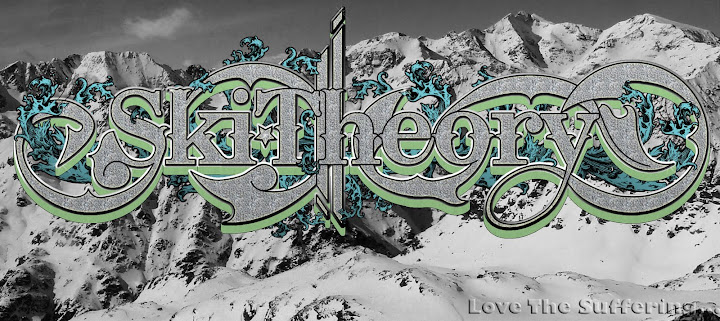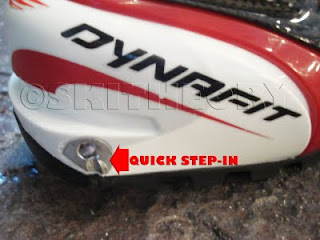The much anticipated Dynafit Dy.N.A World Cup Race boot is here, and is building a strong following already. The design pulls from many great designs, taking the advantages of all the race boots on the market (and off), and combining it into one. As a racer I try to constantly find even the smallest advantage over the competition. Looking into many different schools of thoughts on race boots, I found that the Dy.N.A combined all of them in their own way.
Carbon, the beautiful sleek lightweight, makes the boot stiff and burlier than you would think. Even without a tongue to add extra stiffness, this boot is surprisingly stiff, unlike many other uber light gear out there. Combined with its build, it is designed for performance.

 First of all let’s talk about the massive rearward cuff rotation. It allows 62º of plantar flexion of the foot in the boot, allowing you to extend your stride way out in front. This adds tens of centimeters of length to your stride. So what does this longer stride mean? Well, if you were to simply have 5cm longer of a stride, over 1000m of elevation gain, this would equate to an additional 300m of elevation gain. More than this will put you light years ahead of the competition.
First of all let’s talk about the massive rearward cuff rotation. It allows 62º of plantar flexion of the foot in the boot, allowing you to extend your stride way out in front. This adds tens of centimeters of length to your stride. So what does this longer stride mean? Well, if you were to simply have 5cm longer of a stride, over 1000m of elevation gain, this would equate to an additional 300m of elevation gain. More than this will put you light years ahead of the competition. The cuff itself is actually two separate pieces, with two hinges, giving the boot the unrestricted rearward cuff rotation. Most other boots on the market are built with a slightly higher lower boot, which extends into upper cuff, and can reduce your stride length.
The Dy.N.A boots build takes in two schools of thought. The first is that a fully rigid sole with no flex is best suited for steep courses, but does not have as natural a stride on long flat stretches. The second is that a flexible boot, with bellows like the Scarpa F1, the boot has a beautiful stride on long more flat or rolling courses, but does have some energy loss on steep sections. Dynafit combines these ideas as one, and allows the Dy.N.A’s sole to flex only 5mm, giving it a stiff sole for steep ascents, but a more natural stride on flat courses. The advantage to ultra long distance, for example speed traverses, or 12+ hour days, is there is less chance of blistering under the toes and ball of the foot, as a result of excessive motion in the foot from bellows that allow a large amount of flex of the boot sole.
Next comes the Ultra-Lock buckle lock system. This system, much like the Scarpa F1, Pierre Gignoux, and La Sportiva boots, allow the user to undo the upper buckle on the cuff loosening the cuff and simultaneously switching the boot into walk mode. The advantage that the Dynafit boot has over its competition, is there is less chance that you may accidentally break the cable holding the system together, by totally eliminating the cable. The buckle clicks directly into the boots cuff, holding the boot in ski mode when tightened, and allows the cuff to move freely in walk mode when undone.
Have you ever been at a race transition, nearly anaerobic, breathing heavily, and trying to hold your foot still while clicking into your bindings as fast and efficiently in one go? That problem is easily fixed with Dynafit’s quick-step-in inserts. It allows the Dynafit toe pins to slide into the inserts smoothly and with less chance of popping into the wrong spot.
Weight, however, still remains king. The boots Pebax/Carbon build, shaves the weight of the boot down to under 1 kilo, coming in at 920g in a 27.0. Studies have shown that if an athlete takes a single pound off their feet, it equates to six and a half pounds off their back, allowing for less strain and allowing the body to concentrate its energy to what’s important.
So how does it fit? Fantastic! The boots anatomically correct fitting, is perfectly sculpted to the human foot. The heel is slightly narrower, but not overdone, as to cause problems. It keeps the heel snug and free from excessive motion. The area around the metatarsals flares out, allowing the foot to spread out when plantar flexing (pushing off) and able to generate the most amount of power. The toe box even makes sure not to put too much pressure on the big toe, which can cause hallux abduction, and bone spurs.
The liner is the lightest liner on the market. Half the size of the regular Garmont G-Fit or F1 Liner, but has enough foam to ensure there is enough material to mold to the foot, without compromising comfort. The liner itself is less stiff than many others on the market and allows the foot and leg to move freely without fighting the liner.
Only a few rolling into North America this year, so get your hands on the Dynafit Dy.N.A World Cup Race boot, as soon as you can it rocks!









well worth getting stoked over. a great little boot for every day use as they are more durable than a XP, but ski/skin so much better that a F1.
ReplyDeleteStill they don't even come close to a XP for weight or down hill, but nothing else does.